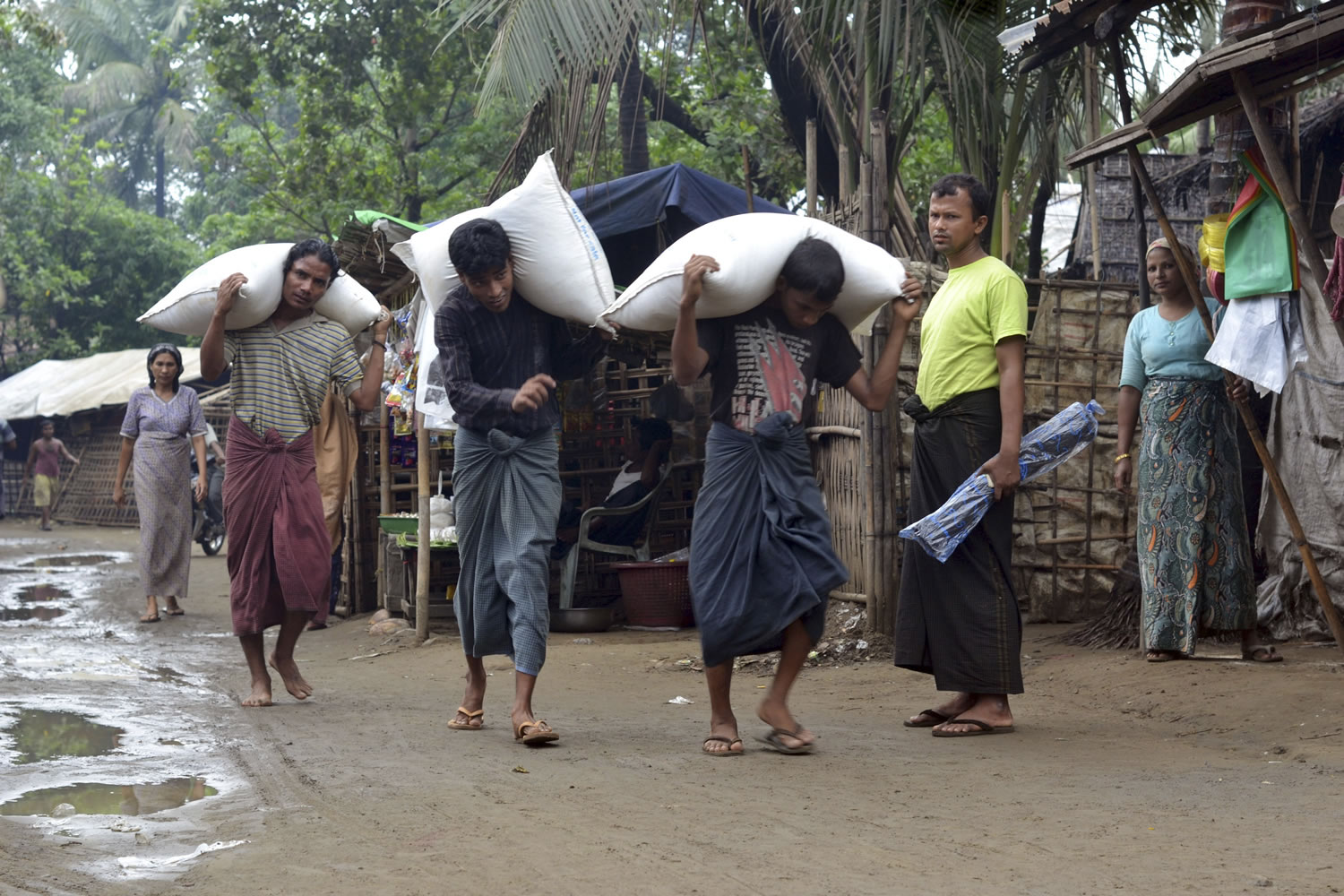SITTWE, Myanmar — The cyclone was only a day or two away, churning through the Indian Ocean and carrying with it winds and rains that authorities warned could quickly turn deadly.
But in dozens of refugee camps that spatter Myanmar’s western coast, where tens of thousands of displaced Rohingya people live in plastic-roofed tents and huts made of reeds, an order to evacuate ahead of the storm was met with widespread refusal.
In these camps, filled with people who barely exist officially, nearly any government order is distrusted.
Around 140,000 people — mostly Rohingya — have been living in crowded camps in Myanmar’s Rakhine state since last year, when two outbreaks of sectarian violence between the Muslim minority and ethnic Rakhine Buddhists forced many Rohingya from their homes.
Nearly half the displaced live in coastal areas considered highly vulnerable to storm surges and flooding from Cyclone Mahasen, which is expected to make landfall early Friday.
“They say they’ll take us someplace safe,” said Kyaung Wa, a cycle-rickshaw driver who has spent nearly a year in a series of camps on the outskirts of Sittwe after his house was destroyed in the violence. If his current home is little more than a hut covered with a plastic sheet, he fears ending up someplace even worse, and living deeper in the countryside and away from work.
So he and the vast majority of his neighbors insisted they would stay, along with thousands of other Rohingya along the coastline.
Officials, he said, had been trying to empty his camp for months.
“Now they say, `You have to move because of the storm,”‘ he said. “We keep refusing to go. … If they point guns at us, only then will we move.”
President’s Office Minister Aung Min told reporters Wednesday that the government guarantees the safety of the Rohingyas during relocation and promises to return them to their current settlement when the storm has passed.
Mahasen appeared to have weakened Wednesday, with the cyclone downgraded to a Category 1 storm, according to the U.N.’s Office for the Coordination of Humanitarian Affairs.
However, the center of the cyclone was heading toward Chittagong in Bangladesh and could, “depending on its final trajectory, bring life-threatening conditions for 8.2 million people in northeast India, Bangladesh and Myanmar,” the U.N. office said in a Wednesday storm update.
There was no wind or rain in Chittagong on Wednesday afternoon, but about 170 factories close to the Bay of Bengal were closed in anticipation of the storm.
Cox’s Bazar, a seafront town in Bangladesh in the expected path of the cyclone, experienced drizzling rain and high tides 3 to 4 feet (about one meter) above normal. There was flooding in low-lying areas of several nearby island towns, said Ruhul Amin, a government official, and tens of thousands of people had left their homes for cyclone shelters and schools and government buildings on high ground.
Related heavy rains and flooding in Sri Lanka were blamed for eight deaths earlier this week, said Sarath Lal Kumara, spokesman for Sri Lanka’s disaster management center.
In Myanmar at least eight people — and possibly many more — were killed as they fled the cyclone Monday night, when overcrowded boats carrying more than 100 Rohingya capsized. Only 42 people had been rescued by Wednesday, and more than 50 Rohingya were still missing, said Deputy Information Minister Ye Htut.
Much attention was focused on western Myanmar because of fears over the fate of the crowded, low-lying Rohingya camps.
Myanmar’s government had planned to move 38,000 people within Rakhine state by Tuesday but “it is unclear how many people have been relocated,” the U.N. office said, adding that Muslim leaders in the country have called on people to cooperate with the government’s evacuation.
With sprawling camps still crowded with people, it appeared very few Rohingya had agreed to leave, despite offers of additional food rations.
The ones that had left said they had little choice.
“They just put us on the truck and brought us here,” said Mahmoud Issac, a day laborer now living with his family and about 500 other Rohingya on the grounds of a small mosque. His wife and five children live on the ground floor of a two-room school, while he and the other men sleep on the mosque’s portico.
He has no idea if he’ll be allowed to return to the camp that had become his home.
The Rohingya trace their ancestry to what is now Bangladesh, but many have lived in Myanmar for generations. Officially, though, they are dismissed as illegal aliens. They face widespread discrimination in largely Buddhist Myanmar, and particularly in Rakhine, where many of the Rohingya live.
Tensions remain high in Rakhine nearly a year after sectarian unrest tore through the region and left parts of Sittwe, the state capital, burned to the ground. At least 192 people were killed.
The violence has largely segregated Rakhine state along religious lines, with prominent Buddhists — including monks — urging people not to employ their Muslim onetime neighbors, or to shop in their businesses.
International rights groups and aid agencies urged that the evacuations be stepped up.
The British-based aid agency Oxfam welcomed the government’s evacuation efforts, but said “swifter action is needed to ensure people are moved before the storm hits.”
“It is essential that humanitarian principles are adhered to in moving all affected populations safely to suitable locations and that no one is left out,” the group’s director for Myanmar, Jane Lonsdale, said in a statement.
Weather experts have warned that the storm could shift and change in intensity before hitting land.
Myanmar’s southern delta was devastated in 2008 by Cyclone Nargis, which swept away entire farming villages and killed more than 130,000 people. Two days before hitting Myanmar, Nargis weakened to a Category 1 cyclone before strengthening to a Category 4 storm.



